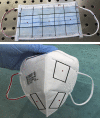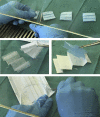The use of germicidal ultraviolet light, vaporized hydrogen peroxide and dry heat to decontaminate face masks and filtering respirators contaminated with a SARS-CoV-2 surrogate virus
- PMID: 32889029
- PMCID: PMC7462546
- DOI: 10.1016/j.jhin.2020.08.025
The use of germicidal ultraviolet light, vaporized hydrogen peroxide and dry heat to decontaminate face masks and filtering respirators contaminated with a SARS-CoV-2 surrogate virus
Abstract
Background: In the context of the ongoing severe acute respiratory syndrome coronavirus 2 (SARS-CoV-2) pandemic, the supply of personal protective equipment remains under severe strain. To address this issue, re-use of surgical face masks and filtering facepiece respirators has been recommended; prior decontamination is paramount to their re-use.
Aim: We aim to provide information on the effects of three decontamination procedures on porcine respiratory coronavirus (PRCV)-contaminated masks and respirators, presenting a stable model for infectious coronavirus decontamination of these typically single-use-only products.
Methods: Surgical masks and filtering facepiece respirator coupons and straps were inoculated with infectious PRCV and submitted to three decontamination treatments, ultraviolet (UV) irradiation, vaporized H2O2, and dry heat treatment. Viruses were recovered from sample materials and viral titres were measured in swine testicle cells.
Findings: UV irradiation, vaporized H2O2 and dry heat reduced infectious PRCV by more than three orders of magnitude on mask and respirator coupons and rendered it undetectable in all decontamination assays.
Conclusion: This is the first description of stable disinfection of face masks and filtering facepiece respirators contaminated with an infectious SARS-CoV-2 surrogate using UV irradiation, vaporized H2O2 and dry heat treatment. The three methods permit demonstration of a loss of infectivity by more than three orders of magnitude of an infectious coronavirus in line with the United States Food and Drug Administration policy regarding face masks and respirators. It presents advantages of uncomplicated manipulation and utilization in a BSL2 facility, therefore being easily adaptable to other respirator and mask types.
Keywords: Decontamination (UV, H(2)O(2), dry heat); PRCV; Respirator; SARS-CoV-2; Surgical mask.
Copyright © 2020 The Healthcare Infection Society. Published by Elsevier Ltd. All rights reserved.
Figures






Similar articles
-
"Don, doff, discard" to "don, doff, decontaminate"-FFR and mask integrity and inactivation of a SARS-CoV-2 surrogate and a norovirus following multiple vaporised hydrogen peroxide-, ultraviolet germicidal irradiation-, and dry heat decontaminations.PLoS One. 2021 May 19;16(5):e0251872. doi: 10.1371/journal.pone.0251872. eCollection 2021. PLoS One. 2021. PMID: 34010337 Free PMC article.
-
The use of germicidal ultraviolet light, vaporised hydrogen peroxide and dry heat to decontaminate face masks and filtering respirators contaminated with an infectious norovirus.Infect Prev Pract. 2021 Mar;3(1):100111. doi: 10.1016/j.infpip.2020.100111. Epub 2020 Dec 28. Infect Prev Pract. 2021. PMID: 34316573 Free PMC article.
-
Filtering Facepiece Respirator (N95 Respirator) Reprocessing: A Systematic Review.JAMA. 2021 Apr 6;325(13):1296-1317. doi: 10.1001/jama.2021.2531. JAMA. 2021. PMID: 33656543
-
Evidence for decontamination of single-use filtering facepiece respirators.J Hosp Infect. 2020 Aug;105(4):663-669. doi: 10.1016/j.jhin.2020.05.032. Epub 2020 May 27. J Hosp Infect. 2020. PMID: 32473179 Free PMC article. Review.
-
Principles and practice for SARS-CoV-2 decontamination of N95 masks with UV-C.Biophys J. 2021 Jul 20;120(14):2927-2942. doi: 10.1016/j.bpj.2021.02.039. Epub 2021 Mar 4. Biophys J. 2021. PMID: 33675766 Free PMC article. Review.
Cited by
-
Evaluation of the Microbiological Effectiveness of Three Accessible Mask Decontamination Methods and Their Impact on Filtration, Air Permeability and Physicochemical Properties.Int J Environ Res Public Health. 2022 May 27;19(11):6567. doi: 10.3390/ijerph19116567. Int J Environ Res Public Health. 2022. PMID: 35682153 Free PMC article.
-
Development of a rapid plasma decontamination system for decontamination and reuse of filtering facepiece respirators.AIP Adv. 2021 Oct 7;11(10):105311. doi: 10.1063/5.0067730. eCollection 2021 Oct. AIP Adv. 2021. PMID: 34646586 Free PMC article.
-
Mask decontamination methods (model N95) for respiratory protection: a rapid review.Syst Rev. 2021 Aug 7;10(1):219. doi: 10.1186/s13643-021-01742-1. Syst Rev. 2021. PMID: 34364396 Free PMC article.
-
Decontamination of N95 respirators against SARS-CoV-2: A scoping review.J Dent. 2021 Jan;104:103534. doi: 10.1016/j.jdent.2020.103534. Epub 2020 Nov 13. J Dent. 2021. PMID: 33197526 Free PMC article.
-
Advanced Research and Development of Face Masks and Respirators Pre and Post the Coronavirus Disease 2019 (COVID-19) Pandemic: A Critical Review.Polymers (Basel). 2021 Jun 18;13(12):1998. doi: 10.3390/polym13121998. Polymers (Basel). 2021. PMID: 34207184 Free PMC article. Review.
References
-
- WHO . vol. 8. 2020. (Strengthening the health system response to COVID-19 Recommendations for the WHO European Region Policy brief).
-
- World Health Organization (WHO) WHO2020; 2019. Rational use of personal protective equipment for coronavirus disease 2019 ( COVID-19 ) pp. 1–7.
-
- Lee J., Bong C., Bae P.K., Abafogi A.T., Baek S.H. Fast and easy disinfection of coronavirus-contaminated face masks using ozone gas produced by a dielectric barrier discharge plasma generator. MedRxiv. 2020 COVID-19 S:1–13. - PubMed
-
- Dutch National Institute for Public Health and the Environment (RIVM) vols. 1–5. 2020. Reuse of FFP2 masks.
MeSH terms
Substances
LinkOut - more resources
Full Text Sources
Miscellaneous

